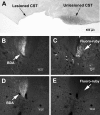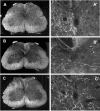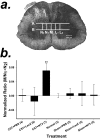Neurotrophin-3 expressed in situ induces axonal plasticity in the adult injured spinal cord
- PMID: 12598631
- PMCID: PMC6742279
- DOI: 10.1523/JNEUROSCI.23-04-01424.2003
Neurotrophin-3 expressed in situ induces axonal plasticity in the adult injured spinal cord
Abstract
The mammalian CNS lacks the ability to effectively compensate for injury by the regeneration of damaged axons or axonal plasticity of intact axons. However, reports suggest that molecular or cellular manipulations can induce compensatory processes that could support regeneration or plasticity after trauma. We tested whether local, sustained release of the neurotrophic factor neurotrophin-3 (NT-3) would support axonal plasticity in the spinal cord distal to the site of injury in rats. The corticospinal tract (CST) was cut unilaterally at the level of the medulla. This avoided excessive inflammation, secondary cell death, vascular disruption, and the release of inhibitory molecules in the lumbar spinal cord. A replication-defective adenoviral vector (Adv) carrying the NT-3 gene (Adv.EFalpha-NT3) was delivered to the spinal motoneurons by retrograde transport through the sciatic nerve. Retrograde transport of the adenoviral vectors avoided the inflammatory response that would be associated with direct injection into the spinal cord. Transduction of spinal motoneurons with Adv.EFalpha-NT3 resulted in a significant increase in the concentration of NT-3 in the L3-L6 region of the spinal cord for up to 3 weeks. In animals with a CST lesion, this local expression of NT-3 induced growth of axons from the intact CST across the midline to the denervated side. If the CST remained intact, overexpression of NT-3 did not lead to an increase in the number of axons crossing the midline. These data demonstrate that local, sustained expression of NT-3 will support axonal plasticity of intact CST axons after trauma-induced denervation.
Figures







Similar articles
-
Neurotrophic factors expressed in both cortex and spinal cord induce axonal plasticity after spinal cord injury.J Neurosci Res. 2003 Oct 15;74(2):221-6. doi: 10.1002/jnr.10718. J Neurosci Res. 2003. PMID: 14515351
-
Expression of neurotrophin-3 promotes axonal plasticity in the acute but not chronic injured spinal cord.J Neurotrauma. 2006 Aug;23(8):1254-60. doi: 10.1089/neu.2006.23.1254. J Neurotrauma. 2006. PMID: 16928183
-
Immune activation is required for NT-3-induced axonal plasticity in chronic spinal cord injury.Exp Neurol. 2008 Feb;209(2):497-509. doi: 10.1016/j.expneurol.2007.11.025. Epub 2007 Dec 7. Exp Neurol. 2008. PMID: 18191837 Free PMC article.
-
Transplants and neurotrophic factors increase regeneration and recovery of function after spinal cord injury.Prog Brain Res. 2002;137:257-73. doi: 10.1016/s0079-6123(02)37020-1. Prog Brain Res. 2002. PMID: 12440372 Review.
-
Targeting Neurotrophins to Specific Populations of Neurons: NGF, BDNF, and NT-3 and Their Relevance for Treatment of Spinal Cord Injury.Int J Mol Sci. 2017 Mar 3;18(3):548. doi: 10.3390/ijms18030548. Int J Mol Sci. 2017. PMID: 28273811 Free PMC article. Review.
Cited by
-
Unilateral pyramidotomy of the corticospinal tract in rats for assessment of neuroplasticity-inducing therapies.J Vis Exp. 2014 Dec 15;(94):51843. doi: 10.3791/51843. J Vis Exp. 2014. PMID: 25549050 Free PMC article.
-
Strategies for regenerating injured axons after spinal cord injury - insights from brain development.Biologics. 2008 Jun;2(2):253-64. doi: 10.2147/btt.s2715. Biologics. 2008. PMID: 19707358 Free PMC article.
-
Viral-mediated Ntf3 overexpression disrupts innervation and hearing in nondeafened guinea pig cochleae.Mol Ther Methods Clin Dev. 2016 Aug 3;3:16052. doi: 10.1038/mtm.2016.52. eCollection 2016. Mol Ther Methods Clin Dev. 2016. PMID: 27525291 Free PMC article.
-
Functional regeneration of respiratory pathways after spinal cord injury.Nature. 2011 Jul 13;475(7355):196-200. doi: 10.1038/nature10199. Nature. 2011. PMID: 21753849 Free PMC article.
-
Brain-derived neurotrophic factor induces proliferation of human airway smooth muscle cells.J Cell Mol Med. 2012 Apr;16(4):812-23. doi: 10.1111/j.1582-4934.2011.01356.x. J Cell Mol Med. 2012. PMID: 21651720 Free PMC article.
References
-
- Baumgartner BJ, Shine HD. Neuroprotection of spinal motoneurons following targeted transduction with an adenoviral vector carrying the gene for glial cell-line derived neurotrophic factor. Exp Neurol. 1998a;153:102–112. - PubMed
-
- Baumgartner BJ, Shine HD. Permanent rescue of lesioned neonatal motoneurons and enhanced axonal regeneration by adenovirus-mediated expression of glial cell-line-derived neurotrophic factor. J Neurosci Res. 1998b;54:766–777. - PubMed
-
- Brösamle C, Schwab ME. Cells of origin, course, and termination patterns of the ventral, uncrossed component of the mature rat corticospinal tract. J Comp Neurol. 1997;386:293–303. - PubMed
Publication types
MeSH terms
Substances
Grants and funding
LinkOut - more resources
Full Text Sources
Other Literature Sources
Medical
Research Materials
